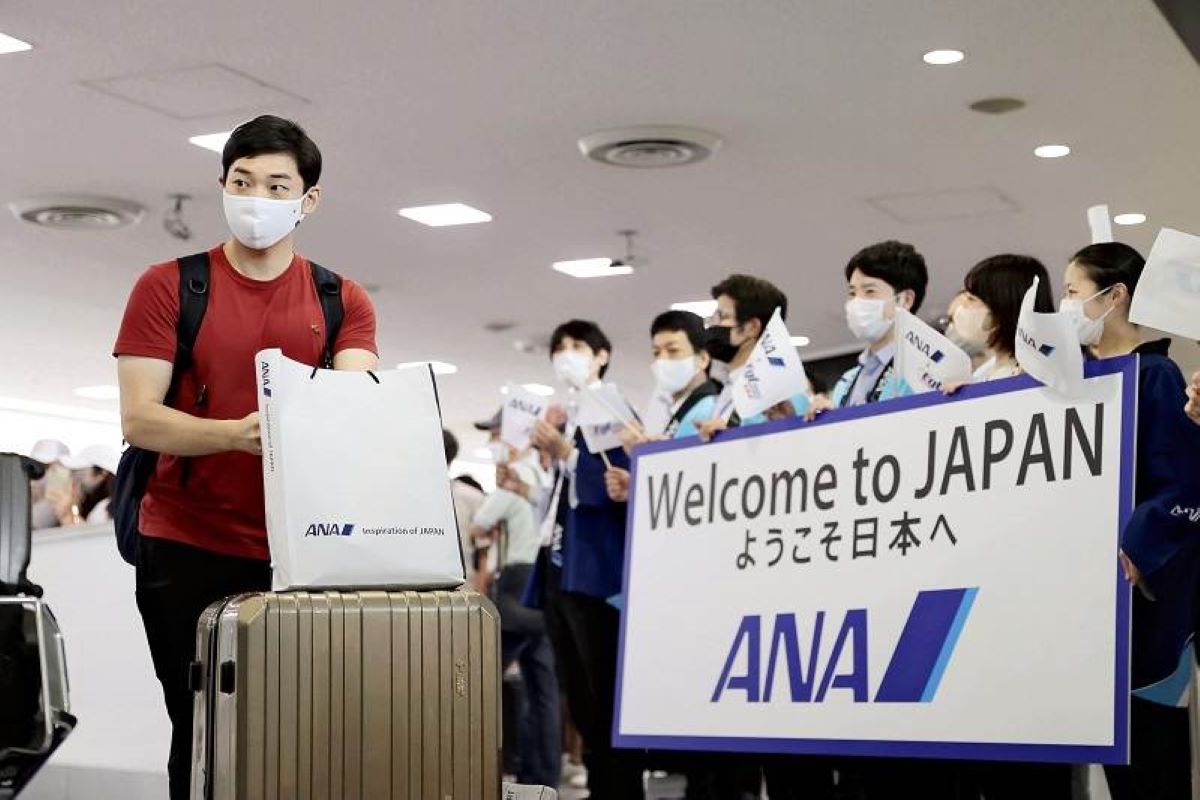Japan’s Path
Japan's enduring economic challenges serve as both a cautionary tale and a beacon of resilience.
The country’s border control measures, considered the strictest among the Group of Seven industrialized nations, have prompted many calls from the business community to relax them, claiming that the country is in a “state of seclusion.”

Airline ground staff hold a sign to greet international travelers in the arrival lobby at Narita Airport on June 22. (Yomiuri Shimbun file photo)
Prime Minister Fumio Kishida, now visiting New York, announced his intention to increase the number of inbound travelers to Japan by lifting the current ban on the acceptance of individual foreign travelers from Oct. 11.
He hopes to attract foreign visitors in autumn, the height of the tourist season, even taking advantage of the weak yen to do so, thus using tourism as a catalyst for economic recovery from the COVID-19 pandemic.
Business community pleas
Advertisement
“Japan is a country that has prospered through the free flow of people, goods and money to and from the rest of the world,” Kishida said in a speech at the New York Stock Exchange on Thursday, emphasizing the importance of tourists and other visitors to Japan for the Japanese economy. He continued, “COVID-19 has temporarily interrupted all of these benefits.” He then announced a drastic relaxation of border control measures.
The country’s border control measures, considered the strictest among the Group of Seven industrialized nations, have prompted many calls from the business community to relax them, claiming that the country is in a “state of seclusion.”
From Oct. 11 onward, the cap on the number of people entering Japan, which has applied to Japanese as well as foreigners, will be eliminated, and the ban on individual travel by foreigners will also be lifted. The visa-free short-term stay measures will also be reinstated. These measures mean that entry procedures, which began to be restricted in February 2020, will be restored to their pre-COVID state, a development that drew welcoming applause from the investment-related officials who filled the venue.
‘It seems like years’
However, the G7 nations other than Japan have already lifted their entry restrictions, so there is no denying that Japan is far behind them in this regard.
In a speech he made in the United Kingdom in May, Kishida announced that there would be “as smooth an entry of people into Japan as seen in other G7 countries” starting in June. However, with the arrival of the seventh wave of infections, it took another four months to realize the plan.
There is a noticeable difference between Japan and other G7 countries, not only in border control measures but also in the level of enthusiasm for “living with the virus,” which describes life returning to normal even though the novel coronavirus continues to exist.
During his latest visit to the United States, Kishida and his accompanying officials saw a New York that does not seem to be suffering from the COVID-19 pandemic. Kishida walked between hotels and other venues for meetings and talks, but there was a stark contrast between the prime minister and his delegation wearing masks even outdoors and the U.S. government officials and others walking near them without wearing masks.
When then Prime Minister Yoshihide Suga visited the United States in April 2021, Washington was also on high alert, and when Suga held talks with U.S. President Joe Biden, he was asked to wear a medical mask.
This time, Kishida and Biden held talks with no masks, occasionally with their faces close to each other. One accompanying person commented, “It’s only been a year and a half [between the Suga and Kishida visits], but they seem like many years apart.”
Adjustments ahead
To increase the number of foreign tourists to Japan, some challenges remain. One matter of concern is trouble possibly caused by differing attitudes toward the wearing of masks. The government plans to call on foreign tourists to wear masks in crowded places while also advising foreigners and Japanese people alike that they are not required to wear masks outdoors when they can maintain a distance from others.
The limited number of airport quarantine staff has also been a barrier to the expansion of the entry limit thus far.
For this reason, the government is expanding the scope of travelers who are exempt from inspection upon entry. Countries and regions around the world are color-coded as blue, yellow and red in ascending order of infection risk. Those entering from blue and yellow countries are exempt from pre-departure and entry inspections if they have proof of having received the third dose of vaccine. At present, there are 128 blue countries or regions, 73 yellow ones and none that are red. A senior official of the Health, Labor, and Welfare Ministry said the ministry is making rapid preparations while assuming that “even if the entry cap is removed, the quarantine burden will not increase so much, and the current system will be sufficient to handle the new situation.”
Advertisement